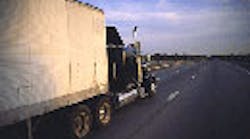While wholesale distribution is on the rise overall, the tough economy has left some sectors struggling to maintain their market position, an analyst said.
Pembroke Consulting has released the third edition of its market data reference guide for the U.S. wholesale distribution industry, offering detailed statistics and analysis of 19 sectors and 112 sub-sectors within the industry.
“In general, distribution has been growing faster than GDP and the overall economy,” Adam Fein, PhD, the author of the study and president of Pembroke Consulting, told FleetOwner.
"Revenues of wholesaler-distributors grew by 8.6% in 2007, marking another year of strong overall performance. However, the performance of individual sub-sectors varied more than in previous years," Fein said. "The ongoing surge in commodity prices continues to ripple through wholesale distribution. Some sectors actually shrank in 2007 after revenues are adjusted for price inflation."
According to Fein, some of the 19 sectors—notably building materials--are very tied to the economy, while some have no correlation to the economy and may perform counter-intuitively to economic strength, such as pharmaceuticals.
Rapidly increasing commodity price inflation has caused some industries—especially food, gas, and chemical—to grow very quickly and rack up large revenues. However, commodities prices have increased so substantially in the past 12 to 18 months that it has become uncharted territory for many distributors, Fein said. In the short term, inflation often benefits a distributor, but it may not in the long term, he added.
The most notable commodity right now is fuel, but Fein said the high prices are not heavily affecting distributors. “For non-fuel and gas distributors, it raises operating costs, but on the other hand, it is an external cost so they have been able to pass on some or all of the fuel costs to consumers,” he said.
Fein said that overall economic growth in 2008 would be slower than it was in 2007, with manufacturing in a slight cyclical downturn and residential housing, which declined 13% last year, far down and unlikely to rise this year.
The largest of the wholesale markets is food distribution, with the $500 billion industry representing about 12% of total wholesale. According to Fein, food prices were up about 5% in 2007, more than double normal inflation, causing food distribution to grow faster than it has in several years, with a 6.2% growth in actual revenue adjusted for inflation.
According to Fein, motor vehicle sales grew 5-10% from 2005 to 2006, but started to level off in 2007 and became negative versus inflation in the fourth quarter. Overall more than 1 million less vehicles were purchased in 2007 than in 2006. Parts, however, were not as affected. In fact, Fein said, when vehicles stay on the road longer, fleets will most likely need to purchase more parts, driving up the segment.
The Pembroke factbook is available for purchase (in PDF form) either in its entirety or in the 19 individual sections. The reports include economic analyses on each sector, benchmarking data, trends, operating statistics, sector-specific price indexes and end-customer market revenue, Pembroke said.


